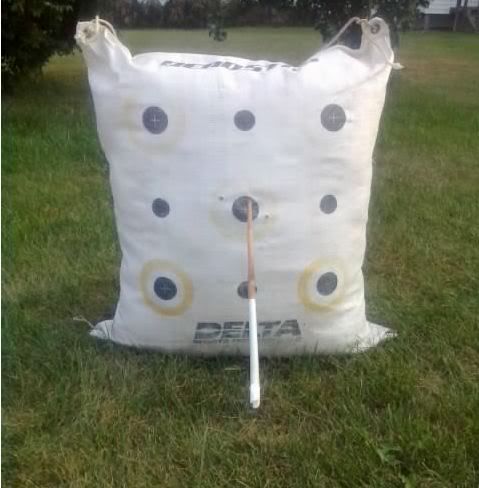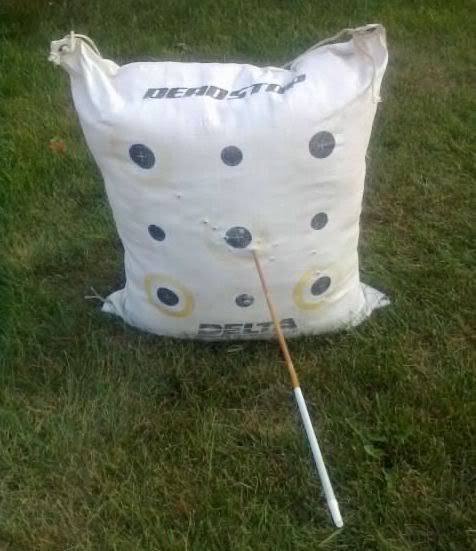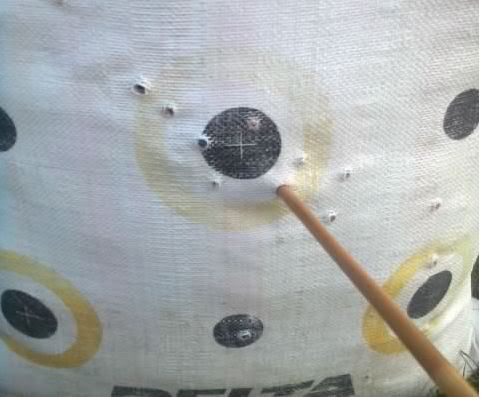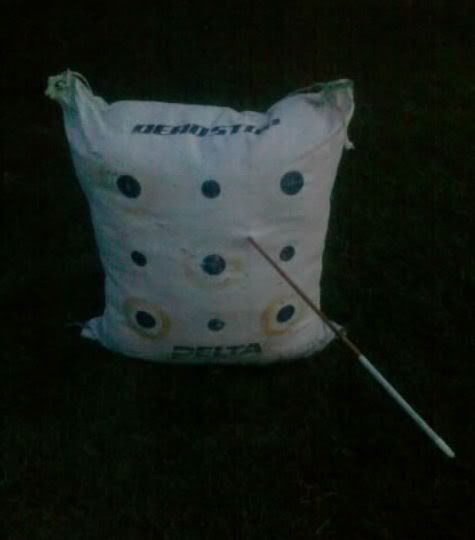Home › Forums › Friends of FOC › Ok, Fine…….bareshafting help.
-
AuthorPosts
-
-
Ok fine……I did it.
I took multiple shots (it’s freaking HOT out!!) at 10, 12 and 15 yards. The first photo is 10 yards, second 15 yards and last is a group (kinda…someone else shot the “flyers” HONEST! 🙄 but I called them) photo all shot with a 635grain (as is) 29 inch tonkin cane, 190 grain field point, no fletching, outa my way not centershot 1952 46lb Bear Cub.
This telling me anything?
I’m ready to throw feathers on this one and make more.



God Bless
Steve Sr. -
Them puppies don’t look too bad. What happens if’n yous back yor self up to say thirty yards?
It’s hell trying to type hic.:D
Troy
-
Troy Breeding wrote: Them puppies don’t look too bad. What happens if’n yous back yor self up to say thirty yards?
It’s hell trying to type hic.:D
Troy
Probably the same thing that happens with any arrow I shoot at 30 yards (I dont practice that far often other than stumping, I HATE shooting targets!)………..I’d M M M MMMMISS!
46lb longbow and 600 plus arrows….past the early 20s yard line…yikes! I need more practice there.
I might try that with feathers on it though….(old habits die HARD!)
Thanks and God Bless
Steve Sr. -
Mmmmmiss?
Hey,, watch your mouth.. This is a family site and we don’t like folks using those four letter words…:roll:
Shooting at targets that far is fine. Nothing lost, but alot to gain. Now, if it’s real then it’s another story. It better be big and look like it’s got a rocking chair on top of it head, and have been standing there for some time before I’ll chance a shot that far.
Troy
-
Just for you, Troy, and any help you and Doc can give me.
To be honest, my second shot. First (as expected) hit low and STRAIGHT down from this arrow in the bottom of the target. Ive not shot far with this heavy of a shaft ever from this bow so isnt a surprise to ME. 😆
This is the second shot. Same arrow, Same bow. 26 yards.Any further back I’d be in cornfield. No time to move target since 20 minutes past sundown and losing sight of the target “dots” with these old eyes but…. HEY! It’s just like shots out HUNTING. About half mine in the PM end up in this light.
I feel the off angle of the arrow is due to the target material more than flight but what do I know. The first low shot was not angled off to the right like this second one either. Target is TOUGH on the outside and sometimes a PIA to get arrows to pull out without wiggling them.
There IS hope!
God Bless
Steve Sr.
-
Steve,
Well, that answered just what I thought it would. Your close, real close. If anything, I’d suggest cutting a tiny bit off your shaft.If you look at the first shot it was right there. The second was a tad bit to the right. The third, a bit more. Now the longest shot is even a tad futher to the right.
I’m hoping your right handed. If so, then the POI shows that you are real close and by shorting the shaft a small amount you will have everything right in line.
Troy
-
Yup. Right handed. Shoulda added that.
Kinda shoots going up in point weight much unless I cut off MORE shaft but informative nontheless.
You ARE assuming that I’m a good shot and that might be an issue….. 😛 I need to consider it though. Could be just ME.
I’ll blaze away again tomorrow to see if that is consistant. I have to wonder if EACH tonkin cane (or any natural arrow shaft material) may be different enough that each would need the same go round bareshafting.
Have I mentioned I’m lazy? lol
God Bless and thanks
Steve Sr. -
Steve Sr. wrote: This telling me anything?
Honestly, without a fletched shaft for comparison, not really. Shoot three bare shafts and three fletched shafts at the same distance at the same spot. The difference between where those two groups impact will tell you exactly what’s happening.
-
Okay…..to continue this experiment, I will go forward with this. (I just wrote about 8 paragraphs and forgot to copy them before refreshing……sigh).
Let us consider these facts for use in this discussion.
1. This bow is new to me
2. I do not HAVE properly tuned arrows for it
3. I want to MAKE properly tuned arrows for it.Just WHAT ARROWS would one use to compare TO? Without ALREADY tuned arrows to compare TO……what it the advantage doing so? And WHO SAYS the ARROWS are flying correctly enough to use them as a yardstick? And, more so, are they ACCURATE to use as a yardstick or is “shooting where I look” more than adequate?
Do they have to be the same diameter? The same weight? FOC? Be of the same material due to recovery differences in shaft material?
Also, is not FETCHING CONTACT with the bow (and for those feeling that there IS NONE, then perhaps YOU CAN shoot plastic vanes?) plus feathers adding a bit of rear weight? FOC change?… Different paradox in general with feathers altering flight?… are they not all factors of arrow flight?
IF shafts are tuned to shoot “the same place (and these are dang close)as fletched arrows”…just what does that indicate with them being DIFFERENT? I FULLY EXPECT them to fly AND hit differently.
Pardon me for this and please continue with this conversation.
Prove me incorrect if you will.
At this point? I see no difference from what Ive done with full arrows that have flown well, taken lots of game and left me wanting for nothing for some four decades………without this “extra step”.
I’m simply attempting to understand what possible advantage bareshafting offers. IF there IS a difference of positive outcome, I really, really doubt most hunters (INCLUDING ME) shoot well enough to be able to use it.
Please take no offense. Consider me the Devil’s Advocate if you will.
God Bless
Steve Sr. -
Steeve,
Those are excellent points for discussion. I’ll address them in no particular order.
Yes, you want to use fletched and unfletched arrows that are matched (sans fletching). At first, no, they won’t be tuned. But the difference in point of impact will tell you what an arrow that cannot correct itself in flight (bare shaft) does in comparison to one that can correct itself (fletched shaft). This tells you exactly what the arrow is doing as it leaves the bow, allowing you to know how to make the necessary corrections.
From there you make minor adjustments, shoot, and repeat. When the fletched and bare shafts impact the same place at a reasonable distance, you’re basically tuned (although in the world of competitive shooting, some consider that point only roughly tuned).
No, bareshaft tuning isn’t the only way to skin the proverbial cat. But it is a decent, time-proven way to get the job done.
-
J.Wesbrock wrote: Steeve,
Those are excellent points for discussion. I’ll address them in no particular order.
Yes, you want to use fletched and unfletched arrows that are matched (sans fletching). At first, no, they won’t be tuned. But the difference in point of impact will tell you what an arrow that cannot correct itself in flight (bare shaft) does in comparison to one that can correct itself (fletched shaft). This tells you exactly what the arrow is doing as it leaves the bow, allowing you to know how to make the necessary corrections.
From there you make minor adjustments, shoot, and repeat. When the fletched and bare shafts impact the same place at a reasonable distance, you’re basically tuned (although in the world of competitive shooting, some consider that point only roughly tuned).
No, bareshaft tuning isn’t the only way to skin the proverbial cat. But it is a decent, time-proven way to get the job done.
I think, respectfully, I will discontinue this.
“in the world of competitive shooting” sums it up for me.
Maybe this is where this came from and Ill admit there are shooters with capabilites WAY beyond my own, yet I’m willing to wager some past great shots never bareshafted a single shaft…time proven?)
Yep, I’m older yet “bareshafting” was NOT a term I heard before compounds where miniscule weight arrows, fletching and HIGH speeds are used (with a release). THERE, ANY finite change would blow things to smithereens (and why mechanical heads CAME to be) AND a mechanical release allows for more consistant release. Fine tuning with that set up……I get.
Also shooting untuned arrows with shafts I’m attempting TO tune, the point of impact isnt going to tell me squat. No offense. IF the arrow SHAFT is CAPABLE of flying (yep, was a huge surprise to ME) 26 yards in consecutive shots WITHOUT fletching…my tuning is DONE unless a broadhead and feathers on it prove otherwise and I CANNOT TELL without adding those two items.
For BOWHUNTING purposes, I will concede the “going up and down on tip weight and length” might be a faster deal with a bare shaft but going beyond the point I am now? Feathers are..repeat ARE needed.
As well as a broadhead.
While “roughly tuned” to expert shooters, in the world of bowhunting there isnt anything to gain IMHO going further with bareshafting yet some gains WITH feathers may yet be there from further alterations……but I doubt it.
You can easliy say that I am “missing the point” and that would be totally accurate. I am.
After watching literally hundreds and hundreds of trad shooters I dont believe for once second that 1 in 100 have the capability to get their fingers off the string (at exactly the same draw length) three times in a row consistantly enough to “get more from fine tuning a bare shaft”, and that is on the target range…..forget in the woods.
IMO a PERFECT shaft leaving the bow, bareshaft, is NOT necessarily going to be a PERFECT arrow with fletching of choice OR with a broadhead added. As stated above, too many things CHANGE. If bareshafting, get it close and fletch is my motto, should I continue to use it at all.
IF I made a mistake starting this, I apologize.
The intention is for all of us to THINK, and decide on our own and to cover the ins and outs of bareshafting ideas, AS WELL AS ALL OTHERS. I feel that intention may have been reached and successful, even if I do not agree. Moot point.
WAY TOO MANY things have come about over the past few decades that are heatedly (thank you all for that not happening HERE!) debated and FEW, again IMO, have a single factor I would call advantageous to the bowhunters like myself. The internet can introduce things that YOU may not need/want/can use……all bandwagons are not for everyone.
Yes, there certainly ARE more ways than one to skin a cat yet THIS SUBJECT (view other threads here AND other sites) has reached the point of being indicated that it is “necessary”. Im living proof that it is not and has not been for me and my friends for near a half century.
I’m willing to wager, lots and lots of money I dont have, that it has created unneeded confusion for a great many….. and I repeat the “unneeded”.
IF IT IS WORKING FOR YOU…..go with it! If you have faith in it? Go with it! Ill stand behind anyone having a working and confidence building proceedure of any kind.
Just know that “bareshafting” to a bowhunter is , IMHO….sorry…….”over kill” and I’m yet to be convinced that a better flying FLETCHED HUNTING ARROW with broadhead will be the end result.
I COULD BE WRONG…….but way too many arrows have flown from my bows successfully, without.
Interesting? Oh yessireebob!
Me? Ill trade the extra time needed to do it for the same amount of time scouting or hunting…..where I DO need help!! 😆
God Bless
“NO TOES WERE INTENTIONALLY STEPPED ON IN THIS POST!”Steve Sr.
-
J.Wesbrock wrote: Steve,
Yes, you want to use fletched and unfletched arrows that are matched (sans fletching). At first, no, they won’t be tuned. But the difference in point of impact will tell you what an arrow that cannot correct itself in flight (bare shaft) does in comparison to one that can correct itself (fletched shaft). This tells you exactly what the arrow is doing as it leaves the bow, allowing you to know how to make the necessary corrections.Jason/Dr Ashby/Troy B, please correct me if I’m wrong: The above method of bareshafting compares fletched/bare throughout the process to keep lesser skilled shooters like myself from getting false readings during the testing because we could be just missing right/left and don’t realize it (especially at increased distances).
Dr Ashby stated the following in a thread:
RE: An in depth look at “Bare Shaft Tuning”
Posted Wednesday, August 17, 2011 at 2:16 PMWhere O.L.’s method compares the point of impact between a fletched shaft and the bare shaft to determine the bare shaft’s dynamic spine I use the left-right impact location of the bare shaft in relation to a plumbed vertical line on the target. Only once the dynamic spine is correct do I begin to compare the point of impact between a fletched shaft and a bare shaft, and this is merely used as verification that the dynamic spine, as determined by the bare shaft tuning, is correct. To date I have not had a single incident of the fletched and bare shafts failing to shoot to the same point of impact after the dynamic spine was tuned by this method.
This appears to quicken the initial process by shooting half the amount of arrows (bares only) and thus less fatigue is also a bonus. Fletched shafts do get compared to bareshafts for final confirmation (again to prevent me from influencing the tuning with poor shooting form).
My question: Is this the only difference in the two methods or am I oversimplifying? I see value in both. Until my skills improve, I’m splitting the difference – I shoot three groups of 3 of bareshafts at the vertical line to see a pattern but throw in the occasional fletched just to check my form before I make an adjustment (especially to arrow length – I have a hard time stretching arrows back to length 😆 )
I’d really appreciate your opinions. Mike.
-
So, I’m bouncing between a few threads on bare shaft tuning and want to ask a question again for clarification. I’m good at beating a dead horse…
So, we get the bare shaft to fly to center then compare to a fletched arrow. I’m assuming that the fletched arrow has been trimmed the same as the bare shaft, correct?
Also, if we see the bare shaft fly to a different impact than the fleched arrow, we adjust the bare shaft and also adjust the fletched arrow?
I glued in my insert, so I’m taking it off the south end of the pole. If I need to adjust the fletched arrow, I’ll be refletching. No a problem if that’s the way it needs to be done, but I’ll skip the extra work if it is not necessary.
I pushed a 50 grain brass insert into the first shaft just to check fit and I couldn’t get the dang thing out. So I shot it into the block and, as you would expect, the insert and point now live inside the block…
Thanks for all of your help. d -
Steve,
I kind of came to the same conclusion except… Tuning an arrow with an insert is kind of a pain. I am going to bareshaft just to get ok to decent flight then fletch and tune. I am not a great shooter and looking for groups out to 15yrds can be frustrating.I can get a “vitals” group but to hit consistantly right or left is tough for me right now. I think next year I will start earlier in the tuning season so that I can spread it out over a couple days. Even that can be a challenge.
I seem to be rushing right now in order to get enough practice. This year a 15yrd shot will be max. -
Steve,
Sorry dude, I should have told you the other day that I was going to be out of town for a few days. The OH Trad State shoot was this weekend.
I’ve got to go back now and read everything so I can catch up on what has happened.
Troy
-
Steve,
Well, like they say. You can lead a horse to water, but you can’t make him drink.
For some, the best isn’t good enough. For others good enough is fine.
Troy
-
Bully26,
Bareshafting not only puts you in correct tune it also is a great tool for learning to shoot. The more you shoot, the more you will start to understand what it takes to get that good shot. You can shoot all day with improper tuned arrows and never learn a thing. If you can get two shots to hit the same, then all it takes is stopping and thinking over what just happened. Your release, your way of holding the bow, where you were holding the shaft on the target, everything.
How many times have you taken a shot in the backyard and wondered if it was you or your setup?
Once you have all this under your belt and locked in your head you want catch yourself second guessing that shot of a lifetime.
Troy
-
-
AuthorPosts
- You must be logged in to reply to this topic.

